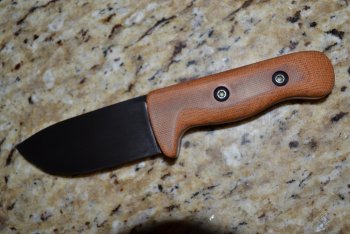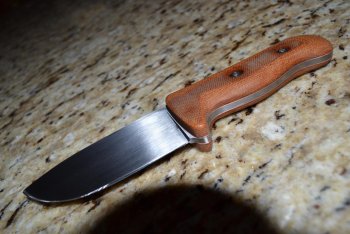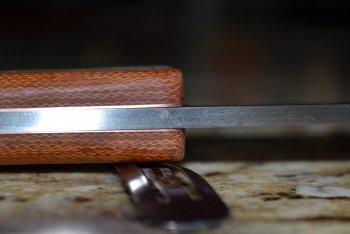Good afternoon, folks.
I've been a long time reader, and decided not long ago to become a member here. First off, I thank all of the people here that post pro-tips and answer questions for those who are trying to get into knife making. It's a big help. I appreciate what you do.
If y'all don't mind, I have a question (problem) that I can't seem to solve, and I'm looking for suggestions.
I'm working on my first commissioned knife, and it's a problem child. It's an O-1 EDC (5/32" thick) with a 3 1/2" blade and micarta handles. My customer wanted O-1 so that he can do his own patina, and as such he wanted to be able to remove the handles. To fasten it mechanically strong (without epoxy and pins), I used 1/4" x 5/16" SS standoffs in between the scales and the tang, with 8-32 high torque button-head screws counter bored into the scales. The scales are micarta with copper liners.
The problem I'm having is the scales will not sit flat on the tang. I have surface ground the knife on the grinder platen (KMG), and surface ground the copper liners as well, followed up with careful hand sanding. I get everything to sit flat and beautiful when I hold it together with my fingers and hold it up to the light, but when I put the screws in the scales lift off the tang at the top and bottom. It seems the flatter I get things, the worse it looks. My understanding as of right now is that the pressure that the screws exert makes the area around the standoffs bulge slightly, which lifts the scales, but I am open to other ideas.
At this point I want to throw this knife in the river, as I have put a ton of labor into making things right, but it's been an uphill battle. I'm a perfectionist, and that comes with a burden. I do not have a surface grinder, but it's on my list as the next piece of equipment to get. Am I going to have to accept some gap with using screws to hold the scales on? I've even made a jig that fits onto the outside of the scales in the screw-holes to put pressure on them like the screws would when tightened; the grind pattern is definitely different, but when I put the knife together the gaps still appear, and really look worse. I would appreciate your thoughts and ideas.
Thank you all very much!
Respectfully,
Carlton
I've been a long time reader, and decided not long ago to become a member here. First off, I thank all of the people here that post pro-tips and answer questions for those who are trying to get into knife making. It's a big help. I appreciate what you do.
If y'all don't mind, I have a question (problem) that I can't seem to solve, and I'm looking for suggestions.
I'm working on my first commissioned knife, and it's a problem child. It's an O-1 EDC (5/32" thick) with a 3 1/2" blade and micarta handles. My customer wanted O-1 so that he can do his own patina, and as such he wanted to be able to remove the handles. To fasten it mechanically strong (without epoxy and pins), I used 1/4" x 5/16" SS standoffs in between the scales and the tang, with 8-32 high torque button-head screws counter bored into the scales. The scales are micarta with copper liners.
The problem I'm having is the scales will not sit flat on the tang. I have surface ground the knife on the grinder platen (KMG), and surface ground the copper liners as well, followed up with careful hand sanding. I get everything to sit flat and beautiful when I hold it together with my fingers and hold it up to the light, but when I put the screws in the scales lift off the tang at the top and bottom. It seems the flatter I get things, the worse it looks. My understanding as of right now is that the pressure that the screws exert makes the area around the standoffs bulge slightly, which lifts the scales, but I am open to other ideas.
At this point I want to throw this knife in the river, as I have put a ton of labor into making things right, but it's been an uphill battle. I'm a perfectionist, and that comes with a burden. I do not have a surface grinder, but it's on my list as the next piece of equipment to get. Am I going to have to accept some gap with using screws to hold the scales on? I've even made a jig that fits onto the outside of the scales in the screw-holes to put pressure on them like the screws would when tightened; the grind pattern is definitely different, but when I put the knife together the gaps still appear, and really look worse. I would appreciate your thoughts and ideas.
Thank you all very much!
Respectfully,
Carlton








